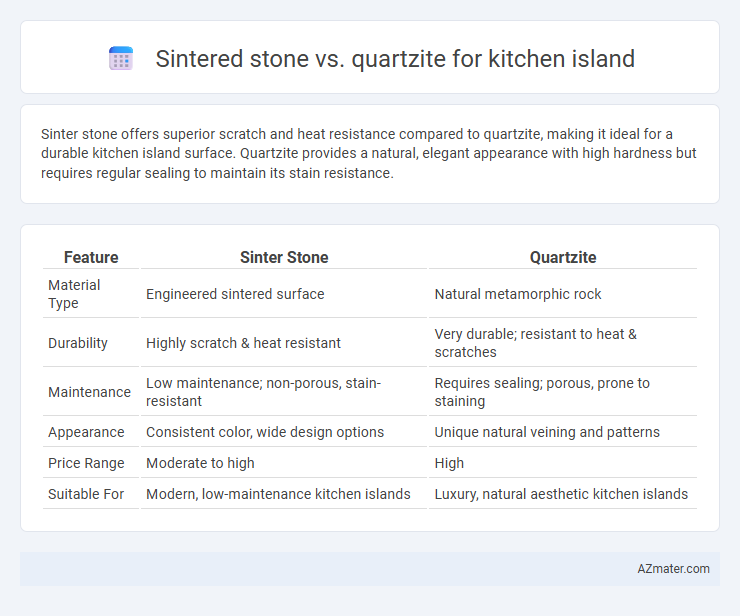Sinter stone offers superior scratch and heat resistance compared to quartzite, making it ideal for a durable kitchen island surface. Quartzite provides a natural, elegant appearance with high hardness but requires regular sealing to maintain its stain resistance.
Table of Comparison
| Feature | Sinter Stone | Quartzite |
|---|---|---|
| Material Type | Engineered sintered surface | Natural metamorphic rock |
| Durability | Highly scratch & heat resistant | Very durable; resistant to heat & scratches |
| Maintenance | Low maintenance; non-porous, stain-resistant | Requires sealing; porous, prone to staining |
| Appearance | Consistent color, wide design options | Unique natural veining and patterns |
| Price Range | Moderate to high | High |
| Suitable For | Modern, low-maintenance kitchen islands | Luxury, natural aesthetic kitchen islands |
Introduction to Sinter Stone and Quartzite
Sinter stone, a highly durable and non-porous engineered material, offers exceptional resistance to scratches, stains, and heat, making it ideal for kitchen islands. Quartzite, a natural metamorphic rock, is prized for its striking natural patterns and impressive hardness, rivaling granite in durability and heat resistance. Both materials provide elegant and practical surfaces, but sinter stone's engineered properties deliver superior stain resistance, while quartzite showcases unique, natural beauty.
Composition and Manufacturing Process
Sintered stone is made from a blend of natural minerals that undergo extreme heat and pressure, resulting in a non-porous, durable surface ideal for kitchen islands. Quartzite is a natural metamorphic rock primarily composed of quartz, formed through the recrystallization of sandstone under intense heat and pressure in the earth. While sintered stone involves engineered manufacturing processes for enhanced performance, quartzite's strength and aesthetics depend on its natural geological formation.
Visual Appeal and Design Options
Sinter stone offers a sleek, contemporary look with a wide range of colors and patterns that mimic natural stone, providing versatile design options for kitchen islands. Quartzite features a natural, marble-like appearance with unique veining, making each piece distinctive and adding elegance to kitchen spaces. Both materials provide durable surfaces, but Sinter stone's engineered consistency ensures uniformity, while quartzite's natural variations create a more organic and luxurious visual appeal.
Durability and Strength Comparison
Sinter Stone offers exceptional durability with high resistance to scratches, heat, and stains, making it ideal for heavy kitchen island use. Quartzite is equally renowned for its hardness and durability, often surpassing granite, and withstands daily wear and tear effectively. Both materials provide strong surfaces, but Sinter Stone's engineered composition enhances impact resistance, while Quartzite's natural crystalline structure ensures lasting strength.
Resistance to Heat and Staining
Sinter stone offers exceptional resistance to heat and staining due to its non-porous surface, making it ideal for kitchen islands exposed to hot pots and spills. Quartzite, while highly durable and naturally heat-resistant, can be more susceptible to staining if not properly sealed because of its slight porosity. Choosing sinter stone provides a low-maintenance option with superior protection against heat damage and stains compared to quartzite.
Maintenance and Cleaning Requirements
Sinter stone offers superior stain resistance and requires minimal maintenance due to its non-porous surface, making it highly resistant to bacteria and easy to clean with mild soap and water. Quartzite, while extremely durable and heat resistant, is more porous and demands regular sealing every 6 to 12 months to prevent staining and moisture penetration. Both materials resist scratches well, but Sinter stone's low maintenance makes it ideal for busy kitchen islands where hygiene and ease of cleaning are priorities.
Cost Analysis: Sinter Stone vs Quartzite
Sinter stone typically costs between $50 and $120 per square foot, offering a durable yet more affordable option for kitchen islands compared to quartzite, which ranges from $70 to $150 per square foot due to its natural stone qualities. Maintenance expenses for sinter stone remain low because of its non-porous surface, while quartzite may incur higher costs over time due to sealing and potential repairs. Evaluating long-term value, sinter stone presents a cost-effective choice with consistent pricing and minimal upkeep, whereas quartzite demands a higher initial investment and ongoing maintenance expenditures.
Installation Considerations for Kitchen Islands
Sintered stone offers superior durability and heat resistance, making it ideal for kitchen island surfaces that endure heavy use and exposure to hot cookware, with installation requiring professional handling due to its weight and brittle nature. Quartzite provides a natural, elegant finish with excellent scratch resistance but demands careful sealing and precise fabrication to prevent chipping during installation. Both materials necessitate sturdy support structures and professional installation to ensure longevity and structural integrity for kitchen islands.
Environmental Impact and Sustainability
Sinter stone offers superior environmental benefits due to its production from natural minerals with low energy consumption and high durability, reducing waste and the need for frequent replacements. Quartzite, while natural and highly durable, often requires energy-intensive quarrying and processing, contributing to a larger carbon footprint. Choosing Sinter stone for a kitchen island supports sustainability through recyclability and minimal environmental impact compared to Quartzite's more resource-heavy extraction.
Final Verdict: Which is Best for Your Kitchen Island?
Sinter stone offers unparalleled resistance to heat, scratches, and stains, making it ideal for a heavily used kitchen island, while quartzite boasts natural beauty with unique veining and excellent durability. Quartzite requires regular sealing to maintain its non-porous surface, whereas sinter stone is typically low-maintenance and highly durable without sealing. For those prioritizing a sleek, modern look with easy upkeep, sinter stone is best; for a natural, luxurious aesthetic with robust performance, quartzite is the optimal choice.

Infographic: Sinter stone vs Quartzite for Kitchen Island
 azmater.com
azmater.com